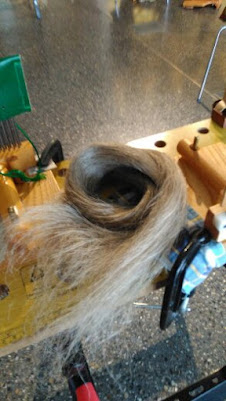Flax
Workshop with Amanda Hannaford Malahide Castle, Sunday February 24th 2019.
On a bright sunny Sunday morning, my comrades-in-spinning and I convened
in the meeting room of Malahide Castle at half past 9. We were each carrying a
selection of rolls of brown paper, old newspapers, rods, lamp stands and
ribbons. Amanda and Ginge had clearly been busy as the room was already set up with
the equipment required to process flax, i.e, a flax-break, a scutching sword and
sets of hackles and combs. On the shelf, we could see a large bundle of ‘straw’
– the flax ! – along with more flax in various steps of readiness.
 |
| Flax fibres |
After our morning cuppa, Amanda showed us how to make a distaff using
brown paper, newspaper and sellotape. Working in pairs, we each made a distaff to
place on our repurposed rods/lamp stands. Amanda also showed us how to dress the
distaff with flax strick. Her distaff looked smashing with red ribbon criss-crossing
on the shiny fibre. It seemed like a very big ask to think that we would all have
a similarly dressed distaff, but never fear, Amanda knew exactly what she was doing.
Soon indeed we did all have lovely conical distaves ready.
Next Amanda took some flax stems from the bundle of ‘straw’. She showed
us how to use the flax-break to break the boon/chives/showes (woody matter) on the
flax stems. Soon the floor under the break was covered with short white bits of
boon that had fallen from the broken stems. This was a very satisfying job, as the
rhythmic ‘chopping’ action turned the stems from stiff straw into wavy fibre in
front of our eyes.
 |
| The flax break, with attached scutching board to the left |
The next step was Scutching to remove the rest of the boon. There was
a large notch at the top of the vertical board at one end of the flax-break. Amanda
took the bundle of broken flax and held one end of it in the notch, while scraping/brushing
down the fibres, removing more of the boon.
Once scutching was done, the bundle of fibres was taken to the hackle.
Amanda showed us the gentle sweeping action required to hackle the flax bit by bit,
removing short or weak fibres and the boon, of course. The shorter fibres that remained
in the hackle are called flax tow and can be carded and spun like wool.
 |
| One of the hackles |
The flax was then hackled on a finer grade hackle and finally combed
through a comb. The transformation from a handful of straw to gorgeous shiny flax
fibres was complete. Lunch time!
 |
| A fistful of lovely silky line flax, having been processed and hackled |
Having seen all the steps involved, we divided into 3 groups, to practice processing some flax ourselves, dressing our distaff and then spinning. One group
started with the flax break. Another took some already broken and scutched flax
and started hackling. The third group dressed their distaves. We rotated around
the different stations and everybody experienced all the steps.
 |
| Above: tow flax (the shorter fibres), Below: line flax (the long fibres) |
Eventually we all had a dressed distaff in place beside our spinning
wheel. We had also each brought with us a small tub or bowl and a sponge. In order
to spin a fine linen thread, one has to spin the flax wet. So we added water to
the sponges in the tubs and carefully listened to Amanda’s instructions.
 |
| My distaff, dressed and ready to go. |
We placed the distaves on their stands, we wet our fingertips in the little bowls, and we drew out a few of the long silky fibres.
 |
| My Camelot spinning wheel, before I started spinning. |
Gradually, we started spinning , one-handed, gently drawing flax fibres
from the distaff , with the other hand dampening the just drafted fibres as we went
along. There was a lot of satisfaction when the linen thread started to build up
on the bobbins around the room.
 |
| Drawing down a few fibres from the distaff as I spin |
There may have been some gnashing of teeth at times, but I do think that we
all thoroughly enjoyed the day and learned lots.


No comments:
Post a Comment
I live in the Irish countryside. I love walking and looking at the sky overhead. I also love spinning! If you have any questions about spinning or any comments about my blog, just let me know by leaving a comment. Thanks.